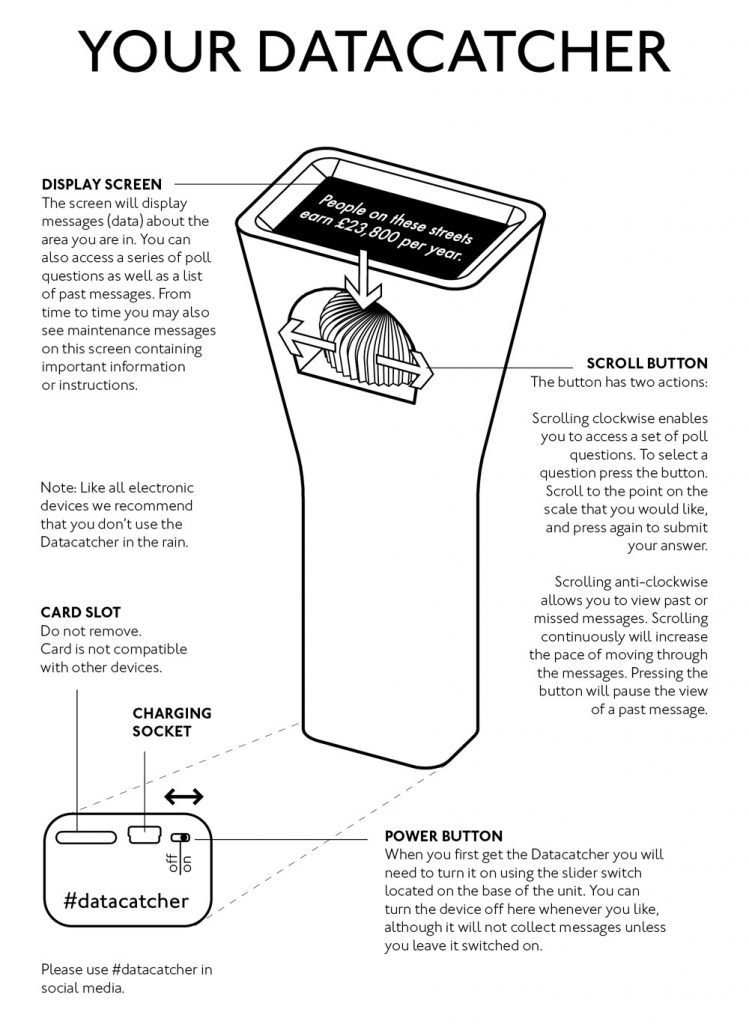Meet The Datacatcher: Gotta Catch’em All!
In their paper “Datacatcher: Batch Deployment and Documentation of 130 Location-Aware, Mobile Devices That Put Sociopolitically-Relevant Big Data in People’s Hands: Polyphonic Interpretation at Scale” [1], William Gaver et. al from the Interaction studio, university of London, they introduced the Datacatcher, a new device they have created and distributed with the help of a service design consultancy to 130 participants in London.
But first, what is a Datacatcher in the first place? It is a location-aware mobile device that displays social, political, economical, and all civic-related information about the area that it’s in. It pulls the information from various big data sources such as governmental resources, Twitter, etc. It can also display random prompts where the users could select one of suggested answers. Tech-wise, it is simply a screen and control wheel that lets you scroll through the messages or prompts and suggested answers. It is battery-operated and comes with a charger just like mobile phones.

In order to find out how will the people perceived such device, and what are the impacts of putting a socio-politically related Big data in people’s hands, they undertook an in-situ research approach rather than using lab studies or other research methods. They worked along with a service design consultancy in order to distribute the devices and they also hired two teams of filmmakers to capture the experiences of people with the device. As much as it is an essential helpful asset to have in your project, delegating the tasks of distribution and filmmaking to external groups had its own tensions as well. Therefore, motivations and meanings had to be negotiated in order to achieve a coherent ‘world’ for the Datacatchers.
A total of 54 films of around 3 hours of footage was collected showing the participants talking about their experience with the Datacatchers [2]. In essence, those films revealed two main forms of engagement with the devices:
The Datacatcher as a product:
The Datacatcher isn’t a device that we are used to see in our daily lives, in fact, it was deliberately design in such way. This unique and weird looking artefact was perceived differently by the participants. While some saw it as a boring, disturbing, too big and sometimes obtrusive, that it was a failure because it should be an app or embarrassing to be seen in public, others have described it as entertaining, amusing, successful and a promoter for social engagement.
Datacatcher as a Socio-political tool
Although the domain objective of the project is to construct a device that would raise awareness around issues related to socio-political inequality and big data, the way participants engaged with the device revealed new dimensions. For instance, participants were questioning the data itself as they perceived the devices as transporters of data that might be informative but also could be inaccurate, obsolete or biased.
Finally, this work illuminates the challenges that come with situated design or research through design, however, it also shows the benefits of such approach over other ways of doing research and how it could unfold many issues that we do not expect. Related to this, I found this work somehow aligns with the motivations behind the work done by Vasilis Vlachokyriakos in Poster Vote [3][4].
Lastly, I would like to end this by asking a question about such initiatives and innovative work, which is what are the outcomes of such work in terms of sustainability and whether it has achieved its aim and were the participants’ expectation addressed? The project’s website is still active however it says that the work on that project has stopped [5].
User Experience
Last week’s topic was about the user experience within HCI and we were asked t discuss a set of reading during the session. Our paper was “Understanding user experience in interactive systems” by Forlizzi J. and Battarbee K. [6]. The authors prupose a framework of user experience, which distinguishes between types of user-product interactions which could be Fluent, Cognitive or Expressive, and types of experiences which are: Experience, An Experience or Co-Experience. The framework was quite confusing for me because of the used terminologies and the loosely defined boundaries between them so there was a lot of overlapping between examples and some could fit in multiple categories. However, this doesn’t mean that this framework is wrong rather it should be more illustrated with concrete example and how we could apply it to the field of HCI.
References
[1] William Gaver, Andy Boucher, Nadine Jarvis, David Cameron, Mark Hauenstein, Sarah Pennington, John Bowers, James Pike, Robin Beitra, and Liliana Ovalle. 2016. The Datacatcher: Batch Deployment and Documentation of 130 Location-Aware, Mobile Devices That Put Sociopolitically-Relevant Big Data in People’s Hands: Polyphonic Interpretation at Scale. In Proceedings of the 2016 CHI Conference on Human Factors in Computing Systems (CHI ’16). ACM, New York, NY, USA, 1597-1607. DOI: http://dx.doi.org/10.1145/2858036.2858472
[2]. https://vimeo.com/search?q=datacatcher
[3]. Vasilis Vlachokyriakos, Rob Comber, Karim Ladha, Nick Taylor, Paul Dunphy, Patrick McCorry, and Patrick Olivier. 2014. PosterVote: expanding the action repertoire for local political activism. In Proceedings of the 2014 conference on Designing interactive systems (DIS ’14). ACM, New York, NY, USA, 795-804. DOI:http://dx.doi.org/10.1145/2598510.2598523
[5]. http://www.datacatcher.org
[6]. Jodi Forlizzi and Katja Battarbee. 2004. Understanding experience in interactive systems. In Proceedings of the 5th conference on Designing interactive systems: processes, practices, methods, and techniques (DIS ’04). ACM, New York, NY, USA, 261-268. DOI=http://dx.doi.org/10.1145/1013115.1013152
Leave a Reply Cancel reply